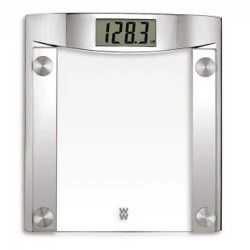Loading ...
Loading ...
Loading ...

• Muscle is also a factor. Heavy-duty resistance training can build muscle, which can
affect weight.
• The menstrual cycle can cause temporary weight gains and losses.
When You’re Losing Weight
It’s important not to put too much stock in the exact number on the scale, because it
can and will vary. This is especially true when you’re dieting. Small weight gains and
losses are common as your body adjusts to fewer calories and more exercise.
Your scale is a valuable tool when used to track weight over a period of weeks and
months. Be aware that different scales often give different results. The scale at your
doctor’s office may show one weight and your scale at home another. So don’t get
too caught up with a single number.
Don’t Overdo It!
A surefire way to get overly concerned with your weight is to weigh yourself too often.
Weigh yourself no more than once a week when you’re dieting. Though it’s hard to
stick to this pattern, it’s the best way to prevent unnecessary concern with normal
weight fluctuations, which are unrelated to your weight-loss efforts. Regardless of
your weighing habits, it’s important that you’re consistent.
Here are 5 rules for effectively monitoring your weight – weigh yourself:
• Once a week, on the same day of the week
• At the same time of day
• In the same place
• Wearing the same clothes
• Using the same scale
To keep track of your weight, record only one number for the week. This will
give you a clear picture of any trend your weight is following.
When You’re Maintaining Weight
Fluctuations in day-to-day weight tend to be smaller when weight is stable, so a more
frequent weigh-in pattern is helpful. To maintain a stable weight:
• Weigh yourself more often than once a week
• Use the “5-pound rule” – research shows that people who keep weight within a
5-pound range are more likely to maintain a healthy body weight over the long term
While a scale can be a useful tool on your weight-loss journey, it’s not in
and of itself a program for losing weight. Come to a meeting and learn from
us the best way to lose and maintain weight. Call 1-800-651-6000 or go to
WeightWatchers.com to find a meeting near you.
FCC Markings:
This device complies with Part 15 of the FCC Rules. Operation is subject to the
following two conditions: (1) this device may not cause harmful interference, and
(2) this device must accept any interference received, including interference that may
cause undesired operation.
Before Using Scale
1. Set switch on the base of scale to measure in kg (kilograms) or lb (pounds).
If your scale does not have a switch, the scale is automatically set to display
weight in lb (pounds).
2. Set scale on floor. Surface must be solid and level for accurate operation
and safety.
Weighing In
1. Quickly and firmly tap center of scale platform with foot to activate digital display.
2. When “0.0” appears in display window, step onto scale.
DO NOT STEP ONTO SCALE UNTIL “0.0” APPEARS IN WINDOW.
3. Stand on platform without shifting or moving until weight is displayed
(4 – 5 seconds).
NOTE: Digital display automatically turns off after several seconds.
Facts You Should Know
Your Weight Watchers scale is a precise measuring instrument that is most accurate
when weighing a stationary object. To ensure the most accurate readings, always
try to stand on the same area of the scale platform and DO NOT MOVE. Should the
weight on the scale exceed the scale’s capacity, you may see an error message “Err.”
Electronic sensors are sensitive. Be careful not to drop or jar the scale. Place it
gently onto floor surface, and store where it will be protected from impact. The scale
is an electronic instrument and should never be submerged in water. Clean with
damp cloth and/or glass cleaner.
Battery Replacement
If battery is low and needs to be replaced, “Lo” will appear on screen. Open the
battery cover on the bottom of the scale and replace the old battery with a 3V lithium
battery (CR2032). Clean the battery contacts and also those of the device prior to
battery installation. Ensure the batteries are installed correctly with regard to polarity
(+ and -). Remove batteries from equipment which is not to be used for an extended
period of time. Remove used batteries promptly. Properly dispose of the old battery.
Do not attempt to open the scale or to remove any components. Servicing
should be done by qualified technicians only. See warranty information
below.
Important Information Concerning Weight
Management
Your scale is the best tool for monitoring weight. While not the only measure of
weight loss, scales are the most popular method used to gauge weight-loss success.
A scale measures the sum of your total body weight, which includes bone, muscle,
fat, and water.
Body weight fluctuates during the day, and from day to day, depending on a
variety of factors.
• Salt and carbohydrate intake can affect the body’s water retention.
• A large meal adds weight and can cause water retention.
• Dehydration from exercise, illness, or low fluid intake can result in weight loss.
ww44y_14ad007371_ib_final.indd 3-4 8/1/14 2:57 PM
